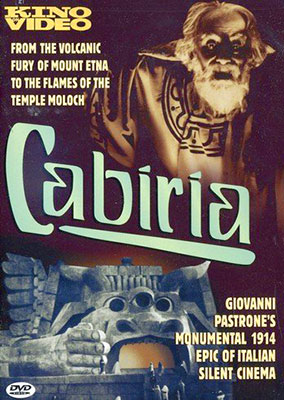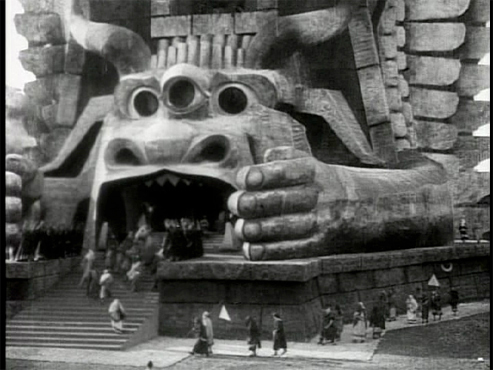
Reviews of silent film releases on home video.
Copyright © 1999-2025 by Carl Bennett
and the Silent Era Company.
All Rights Reserved. |
|
Cabiria
(1914)
|
Early influences on great filmmakers are sometimes forgotten in the wake of later films that historians decide are pivotal. Hence the questionable latter day importance of ‘pioneering’ films such as The Jazz Singer (1927). D.W. Griffith’s mammoth Intolerance (1916), an acknowledged pivotal American feature film, was conceived after a viewing of Cabiria and owes its broad scope and tracking camera movements to its Italian predecessor.
Under the pseudonym Piero Fosco, Cabiria’s director Giovanni Pastrone utilized innovative tracking dolly shots (before they were known as such) that not only freed the camera from the static proscenium effect imposed on the motion picture camera by theatrical and still photography traditions, Pastrone’s moving camera did much to replicate the point of view of an observer moving about within the scene. A first-time viewer of Cabiria can unconsciously expect the stone-still dramatic cinematography of standard silent era films. The first camera movement in Cabiria, only minutes into the film, can have an electric effect on even today’s viewers, and certainly must have been shocking, even unsettling, to audiences of 1914. And note that Pastrone’s camera movements are not the in-and-out movements of Griffith’s Intolerance, they are lateral movements that eschew right angles producing a profound cinematic experience. The influence of such groundbreaking cinematography was immediate and can be seen in American films that predate Intolerance, such as His New Job (1915).
Cabiria also continued the recent Italian tradition of historical epic feature films such as Quo Vadis? (1912) and The Last Days of Pompeii (1913) that were pushing American filmmakers toward a full-time commitment to feature film production. Cabiria features stunning location photography, lavish costumes, ambitious special effects, and jaw-dropping gigantic sets full of intricate design detailing. Conceived as a serious artistic and literary project (the film is divided up into ‘chapters’), Cabiria succeeds on nearly all fronts. For us, the number and length of the verbose intertitles (originally written by Italian novelist Gabriele D’Annunzio) interrupts the flow of the film. D’Annunzio was brought into the project after filming was complete to overlay a literary aura on Cabiria through the use of his name, and he must have felt compelled to make his presence known.
The story of a young Roman girl separated from her parents and thrust into the ancient world has the requisite scope and breadth for an epic tale. For there is no shortage of circuitous events, tragic outcomes, clandestine rescues, and grandiose action that would disappoint fanatics of epic films. We are continually entertained by the sacrificial Moloch cult sequences, with its signature set that influenced films such as Metropolis (1927). The amateur actor Bartolomeo Pagano, discovered as a Genoa dockworker, is famous today as a standout in a competant cast as the Herculian Maciste, protector of Cabiria. Pagano was so successful in his charactization that he continued to portray Maciste in a series of popular Italian films into the twenties.
— Carl Bennett
|
 Kino on Video Kino on Video
2000 DVD edition
Cabiria (1914), black & white, 123 minutes, not rated.
Kino International, K187, UPC 7-38329-01872-6.
One single-sided, single-layered, Region 0 NTSC DVD disc; 1.33:1 aspect ratio picture in full-frame 4:3 (720 x 480 pixels) interlaced scan image encoded in SDR MPEG-2 format at 4.0 Mbps average video bit rate (capable of progressive scan upscaling to 60 fps); Dolby Digital (AC3) 2.0 stereo sound encoded at 192 Kbps audio bit rate; English language intertitles, no subtitles; 15 chapter stops; 2-page insert sheet; standard DVD keepcase; $29.95.
Release date: 7 November 2000.
Country of origin: USA
Ratings (1-10): video: 7 / audio: 7 / additional content: 0 / overall: 7.
|

As a lover of silent era spectacles, we have always cherished watching this influential and groundbreaking Italian feature that was released early in 1914. With its rerelease on DVD home video by Kino International, others may discover this silent era gem and add it to their collections.
Cabiria has been digitally remastered for its 2000 release on home video. The introductory titles have been typographically reset and are more pleasingly readable. But once the film begins, the remastered transfer is virtually identical to the high-quality 1990 home video presentation on laserdisc and videotape by Kino. The intertitles, translated into English by Charles Affron and Mirella Jona Affron, and the music score performed on piano by Jacques Gauthier remain the same. We would have liked to have seen the film’s intertitles reset in the more readable typefont. An A-B comparison of the 2000 DVD and 1990 laserdisc editions reveal that the excellent 35mm print is better represented in the new digital video master. The moderately light transfer of 1990 is now a more detailed and slightly darker transfer. The sharp image detail of the new transfer reveals to trained eyes a detectably softer focus on the left side of the picture, which we suspect is in the film print rather than the transfer since it was less apparent but nonetheless present in the 1990 laserdisc image, but the softness is far from distracting to the viewer. The picture cropping of the new edition appears to be generous and is virtually identical to the 1990 edition. Overall, we prefer this remastered edition for its balanced greyscale picture and sharper image detail.
The film is accompanied by a music score adapted from the 1914 Italian release and performed on piano by Jacques Gauthier.
In reevaluating this DVD edition for play on high-definition systems, we viewed the disc on a full HD monitor with a player capable of resolution upscaling to a 1080p signal. The video transfer and its encoding to DVD hold up for HD viewing, with the picture looking somewhat filmlike despite its standard-resolution NTSC signal. Nonetheless, we have downgraded our video quality rating of this edition as the film could now greatly benefit from a new HD scan released on Blu-ray Disc.
We highly recommend the film Cabiria for the uninitiated silent era enthusiast, and recommend this early digital transfer as a marginally better upgrade for owners of the 1990 edition.
|
|
This Region 0 NTSC DVD edition is available directly from . . .
|

|
|
|
Other ITALIAN FILMS of the silent era available on home video.
Other EPIC FILMS of the silent era available on home video:
Ben-Hur (1925)
Intolerance (1916)
Book : The Maciste Films of Italian Silent Cinema by Jacqueline Reich
|




































